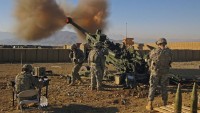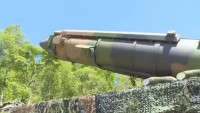US Army Searching for Ways to Defeat ‘Anti-Helicopter Mines’
| Arthur Dominic Villasanta | | Jan 04, 2017 02:58 AM EST |
(Photo : Khan Asparuh Trade) Illustration showing the effect of a Bulgarian anti-helicopter mine system (right).
The U.S. Army is now shopping around for a countermeasure to a threat that seems somewhat incongruous -- the "anti-helicopter mine."
An anti-helicopter mine is a rarely used weapon not standard issue in many armies, including the U.S. Army. In its initial form, the anti-helicopter mine was simply an above ground mine attached to a short stave. The mine detonated when a helicopter hit it upon landing.
Like Us on Facebook
Today's anti-helicopter mines are more sophisticated and lethal, especially those being sold on the world market by Bulgaria, the world leader in producing this weapon. The threat presented by the latest version of Bulgarian (and Russian) anti-helicopter mines has led the U.S. Army (the world's largest helicopter operator) to shop around for a countermeasure.
A new research proposal, "Anti-Helicopter Mine and Improvised Explosive Device Countermeasures," reveals the Army compares the threat faced by helicopters to those faced by infantry and vehicles from IEDs or improvised explosive devices.
The research paper proposes a three step process to counter anti-helicopter mines. It starts with identifying what anti-helicopter mines and IEDs are on the market; their fuzing mechanisms and how they're employed.
A prototype countermeasure will be developed that addresses these issues. The Pentagon will then decide whether to go ahead and build the countermeasure.
Anti-helicopter mines seem to have been developed because shoulder-fired anti-aircraft missiles are ineffective against helicopters flying below 100 meters.
Bulgaria's sophisticated and purpose-built anti-helicopter mines are giving the U.S. Army pause. Among the plethora of these mines made by Bulgaria are the 4AHM-100, AHM-200, AHM-200-1, AHM-200-2, PMN-150 and PMN-250.
The Bulgarian directional fragmentation mines marketed by Khan Asparuh Trade, Ltd can be used with proximity fuzes in their anti-helicopter mines.
The above ground AHM-200, for example, has an acoustic sensor that arms the weapon when it detects the sound of the helicopter as far away as 460 meters. A Doppler radar that's part of the system tracks the target.
When the helicopter gets within 100 meters, the mine or mine network detonates. The warheads are either explosively formed projectiles or explosive charges packed with steel balls.
Tagsanti-helicopter mine, U.S. Army, Bulgaria, Anti-Helicopter Mine and Improvised Explosive Device Countermeasures, Khan Asparuh Trade, Ltd.
©2015 Chinatopix All rights reserved. Do not reproduce without permission
 US Forges Ahead with Plans to Deploy Land-based Artillery to South China Sea Islands
US Forges Ahead with Plans to Deploy Land-based Artillery to South China Sea Islands China Warns of World War III if Sea Battles Erupt in South China Sea
China Warns of World War III if Sea Battles Erupt in South China Sea Soft Exosuit will make US Soldiers less Prone to Fatigue; will Complement Bullet-proof TALOS Armor
Soft Exosuit will make US Soldiers less Prone to Fatigue; will Complement Bullet-proof TALOS Armor US Navy Deploys USS Carl Vinson Strike Group to Asia; Over 100 Fighter Jets Ready for War
US Navy Deploys USS Carl Vinson Strike Group to Asia; Over 100 Fighter Jets Ready for War
EDITOR'S PICKS
-

Did the Trump administration just announce plans for a trade war with ‘hostile’ China and Russia?
-

US Senate passes Taiwan travel bill slammed by China
-

As Yan Sihong’s family grieves, here are other Chinese students who went missing abroad. Some have never been found
-

Beijing blasts Western critics who ‘smear China’ with the term sharp power
-

China Envoy Seeks to Defuse Tensions With U.S. as a Trade War Brews
-

Singapore's Deputy PM Provides Bitcoin Vote of Confidence Amid China's Blanket Bans
-

China warns investors over risks in overseas virtual currency trading
-

Chinese government most trustworthy: survey
-

Kashima Antlers On Course For Back-To-Back Titles
MOST POPULAR
LATEST NEWS
Zhou Yongkang: China's Former Security Chief Sentenced to Life in Prison

China's former Chief of the Ministry of Public Security, Zhou Yongkang, has been given a life sentence after he was found guilty of abusing his office, bribery and deliberately ... Full Article
TRENDING STORY

China Pork Prices Expected to Stabilize As The Supplies Recover

Elephone P9000 Smartphone is now on Sale on Amazon India

There's a Big Chance Cliffhangers Won't Still Be Resolved When Grey's Anatomy Season 13 Returns

Supreme Court Ruled on Samsung vs Apple Dispute for Patent Infringement

Microsoft Surface Pro 5 Rumors and Release Date: What is the Latest?










